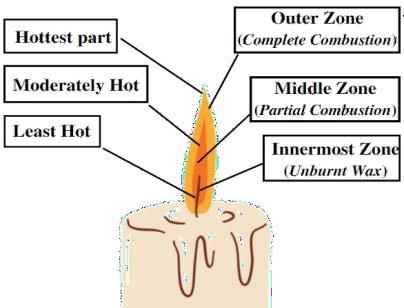NCERT Solutions Class 8 Science Chapter 4 Combustion and Flame FREE PDF Download
FAQs on NCERT Solutions for Class 8 Science Chapter 4 Combustion and Flame
1. What is Combustion?
Combustion is a process in which a substance, burns in the presence of oxygen, or reacts with oxygen to produce heat and light. It is a chemical process.
2. What is meant by Calorific Value?
The calorific value of a substance is the amount of heat energy contained in it. When a certain amount of a substance undergoes complete combustion at a constant pressure, the amount of heat energy released determines the calorific value of the substance. The unit in which the calorific value is measured is kilo-joule per kilogram, KJkg-1.
3. How many Questions are there in the Class 8 Science Chapter Combustion and Flame?
There are 13 questions and answers in the NCERT Solutions for Class 8 Science Chapter 6, Combustion and Flames. The exercise followed by this chapter comprises fill-in-the-blanks, reasoning, short answer type questions, drawing diagrams, and numerical-value type questions. Every question in this exercise helps students assess their understanding of the concepts, and they can find well-explained answers to all the questions in the NCERT Solutions for Chapter 4 Science Class 8 PDF on Vedantu.
4. Can I download the FREE NCERT Solutions for Combustion and Flame class 8 questions and answers pdf?
Yes, you can download the NCERT Solutions for Class 8 Science Chapter 4 Combustion and Flames for free from Vedantu. All you need is internet connectivity and you can download the class 8 Science Chapter 4 question-answer PDF on your computer or laptop. You can find this Solutions’ PDF on Vedantu's official website.
5. What is a flame, according to combustion and flame class 8 PDF?
When you burn something, it becomes hot, and luminous gas emerges from the burnt product. The gas that comes out when you burn something is known as the flame. To learn more about Flames, refer to the combustion and flame class 8 pdf Vedantu, which has detailed answers to all the questions and explains every topic properly. This way, you will not have any doubts and can pass your exams easily.
6. What is combustion according to Chapter 4, Science Class 8?
A chemical reaction in which one given substance reacts with atmospheric oxygen to dissipate heat and light is called combustion.
E.g., burning of paper.
You can learn about this phenomenon in detail with the help of the NCERT solutions by Vedantu for Class 8 Chemistry. With expert knowledge and experience, it will help you understand such complex concepts with ease.
7. What is the difference between Combustion And Flame?
The most basic difference between combustion and flame is that combustion refers to only heating without any flames because most of the energy gets converted to heat during burning, thereby leading to less light energy compared to flame. In case flames are created during the process of combustion, it is known as burning.
8. Why does paper burn with a yellow flame according to Chapter 6 of Class 8 Science?
An insufficient flow of oxygen while combusting this piece of paper leads to the production of solid carbon particles, which rise through the flame. These particles become hot, burn and ultimately give a yellowish light. That is why a piece of paper will usually burn with a yellow flame.
Chapter 4 Science class 8 Science is available free of cost on the Vedantu website and on the Vedantu app. These solutions have more such experiments and their answers to help you understand complex phenomena easily.


















